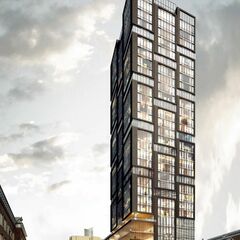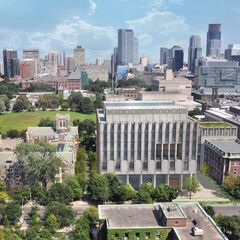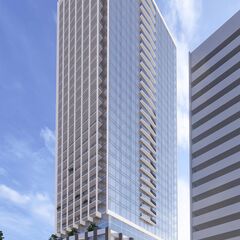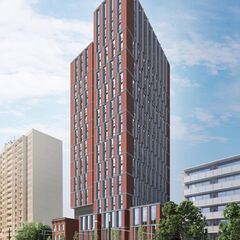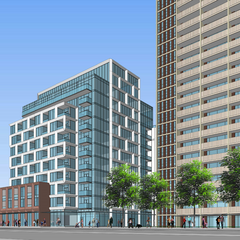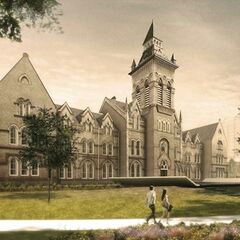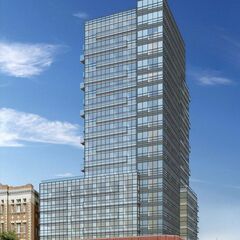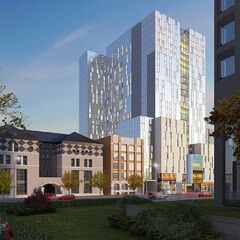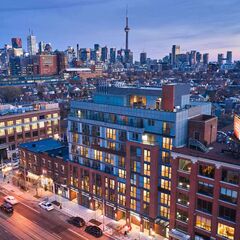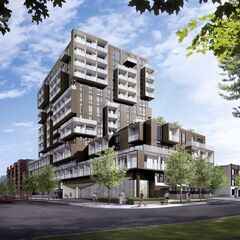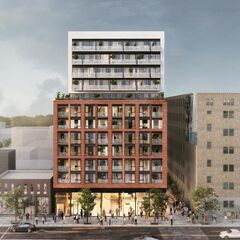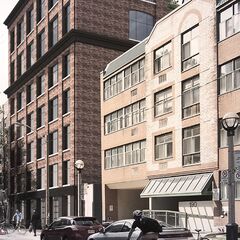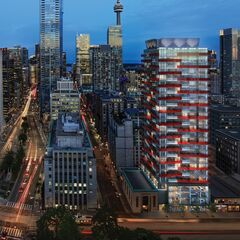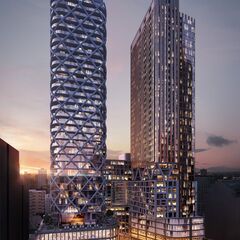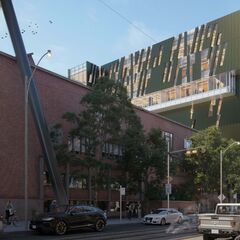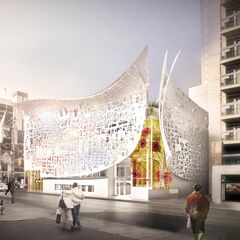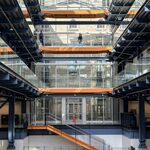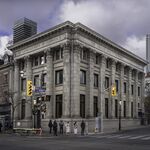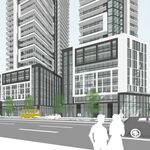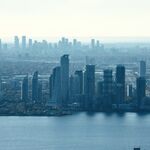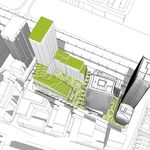Welcome to another instalment of 2017's Growth To Watch For Series. This segment continues on from our Downtown North tour, starting off in the University of Toronto's (U of T) St. George Campus, then going west on College all the way to Dovercourt Road. From there, we head back downtown via Dundas Street and Alexandra Park. From there we check out development in Queen West, and then it's up to the AGO/OCAD area to see what's coming there.
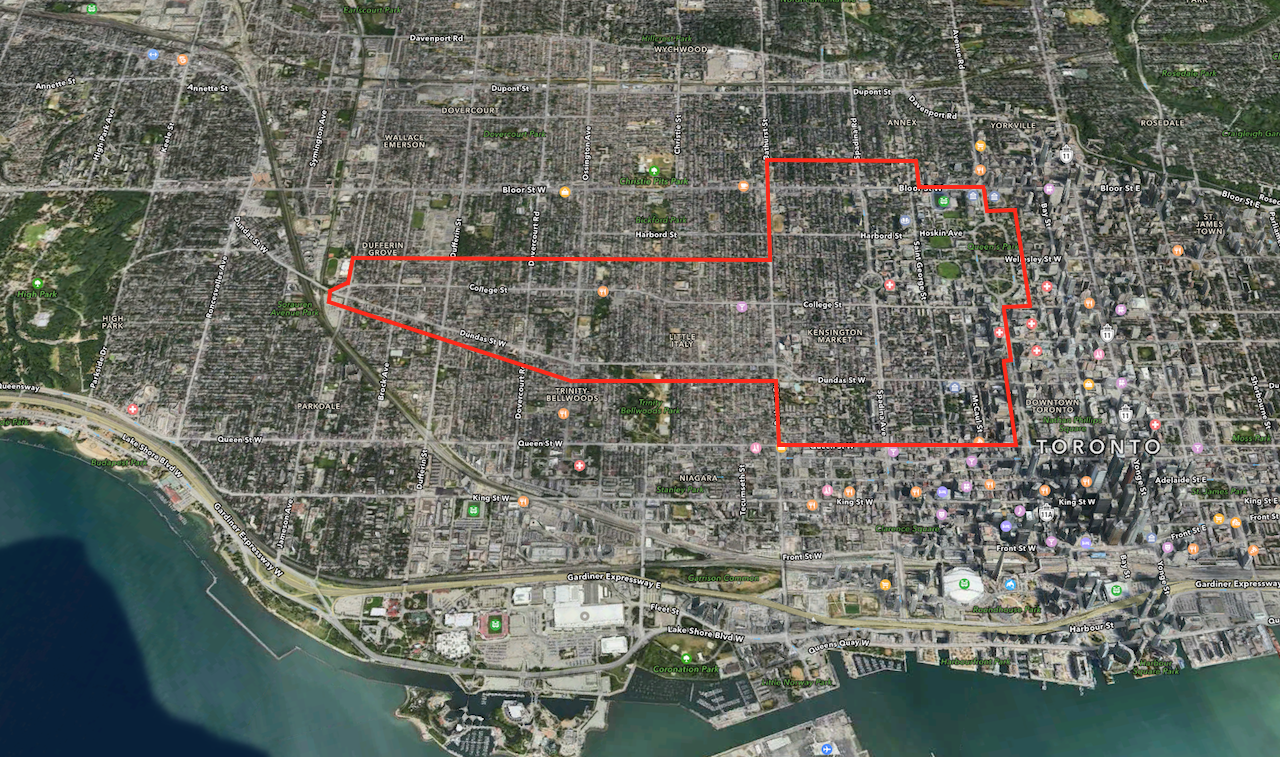 Boundary of the West of Downtown/U of T Growth To Watch For area, image via Apple Maps
Boundary of the West of Downtown/U of T Growth To Watch For area, image via Apple Maps
Our first project, a replacement of the McLaughlin Planetarium by the U of T with a new Centre for Civilization and Cultures, is controversial for the fact that it irrevocably seals the fate of the star show and Laserium facility that has been shuttered now since 1995. Though attendance at the facility was apparently less than stellar, the lack of a proper planetarium in Toronto still wounds civic pride. The 1968-built domed building is both a fine example of mid-20th century architecture and a unique structure, but the U of T needs the land.
In the fall of 2014 the school announced plans for a new facility here, which they called a "mega-cultural complex" which would include space for a new Jewish Museum of Canada, a new performance hall for the Faculty of Music, and offices for several other departments, about 13 storeys tall. In January 2016, the school announced that Toronto's own architectsAlliance would partner up with New York's Diller Scofidio + Renfro to design the new facility, but with the Jewish Museum no longer part of the program. This January, City News reported on an effort to preserve the planetarium via a petition has over 7,330 signatures so far. The report also stated that artists' renderings of the new proposal should be ready this summer.
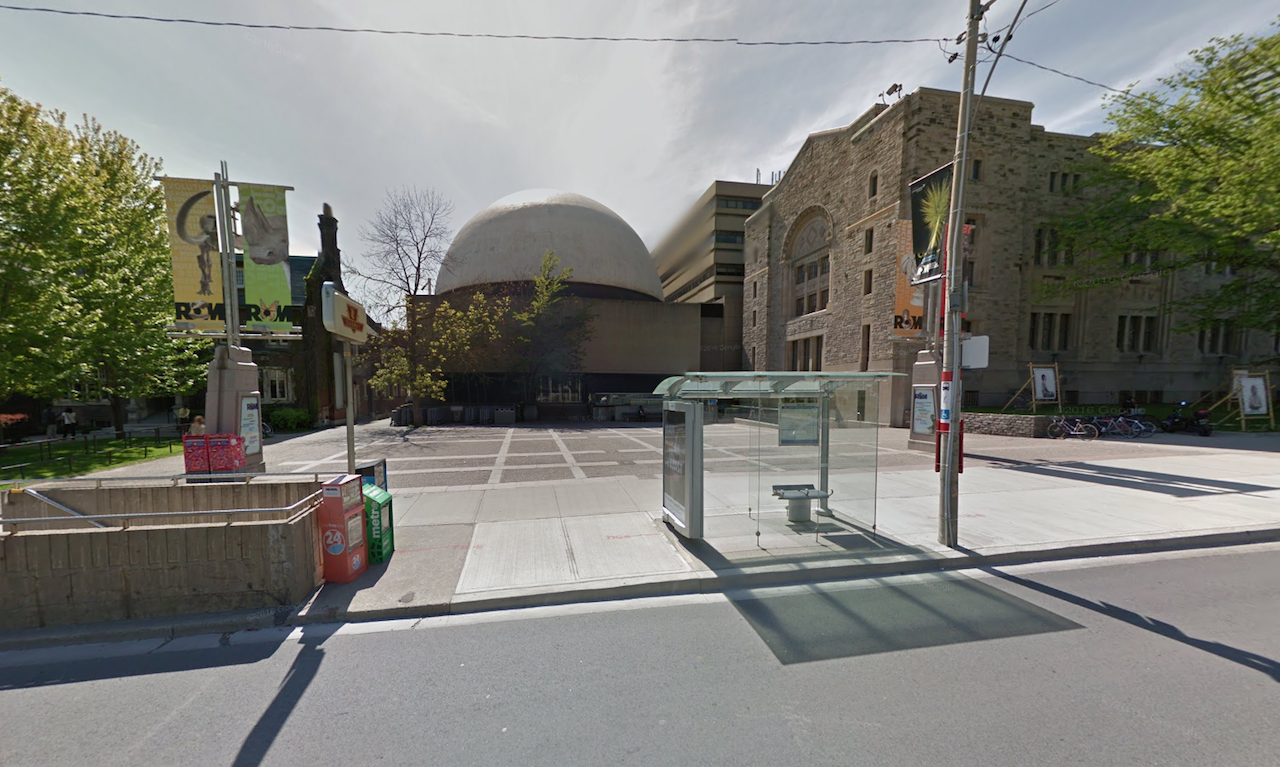 Street view of the McLaughlin Planetarium, image courtesy of Google Maps
Street view of the McLaughlin Planetarium, image courtesy of Google Maps
Next up at U of T is the Landscape for Landmark Quality project. A competition to redesign the St. George campus was awarded to KPMB Architects, Michael Van Valkenburg Associates, and Urban Strategies in late 2015 to transform the campus to a car-free, pedestrian only space. Circling the historic campus with new paths dedicated for cyclists and pedestrians, and moving parking underground, the project has now been submitted to the City, looking for the enactment of a new St. George Campus Secondary Plan.
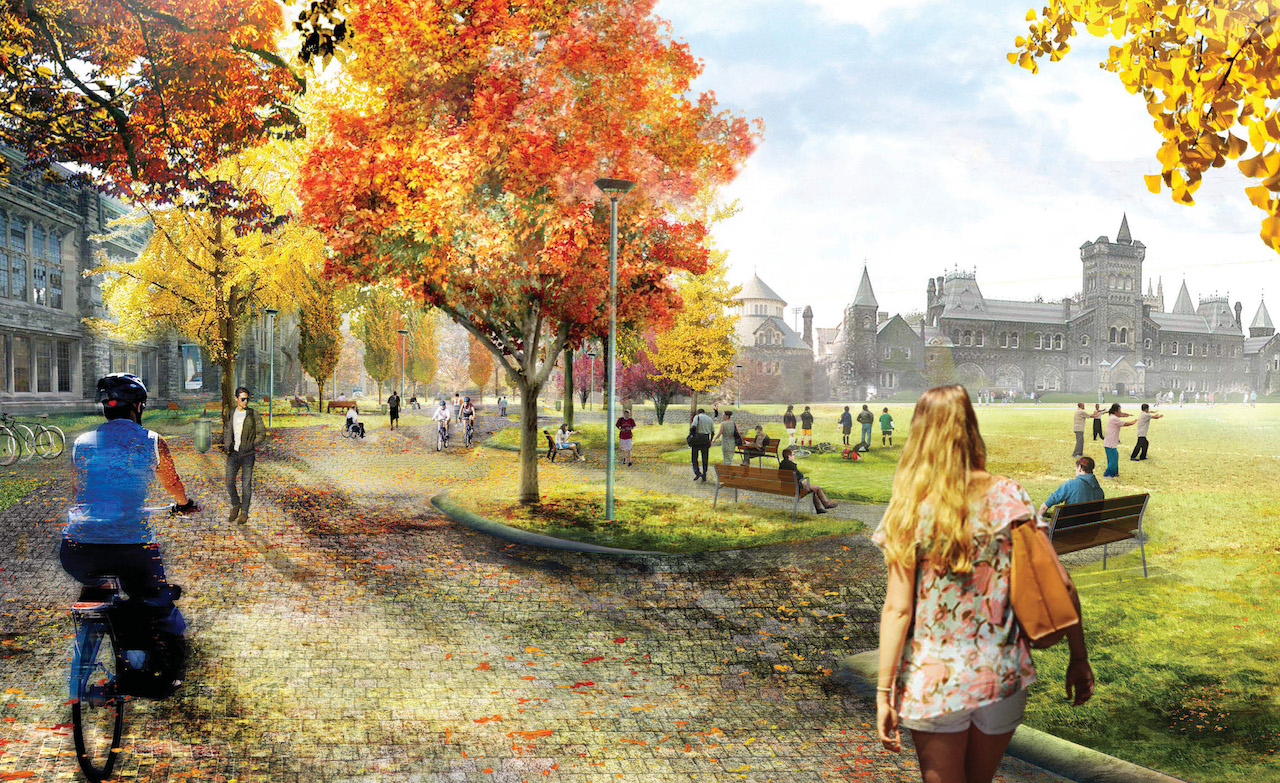 Rendering of Landscape of Landmark Quality, image courtesy of KPMB/MVVA
Rendering of Landscape of Landmark Quality, image courtesy of KPMB/MVVA
The St. George Campus is expansive, and non-exclusive, blending with other institutions like the provincial government offices of Queen's Park, and the hospitals of University Avenue. Moving through the campus down to 92 College Street, a Victorian house that had been home to the Department of Obstetrics and Gynaecology was demolished in August last year, and for the time being is an extension of the existing surface parking lot on site. This site is part of U of T's Site 14, reserved for future development in the new Campus Master Plan.
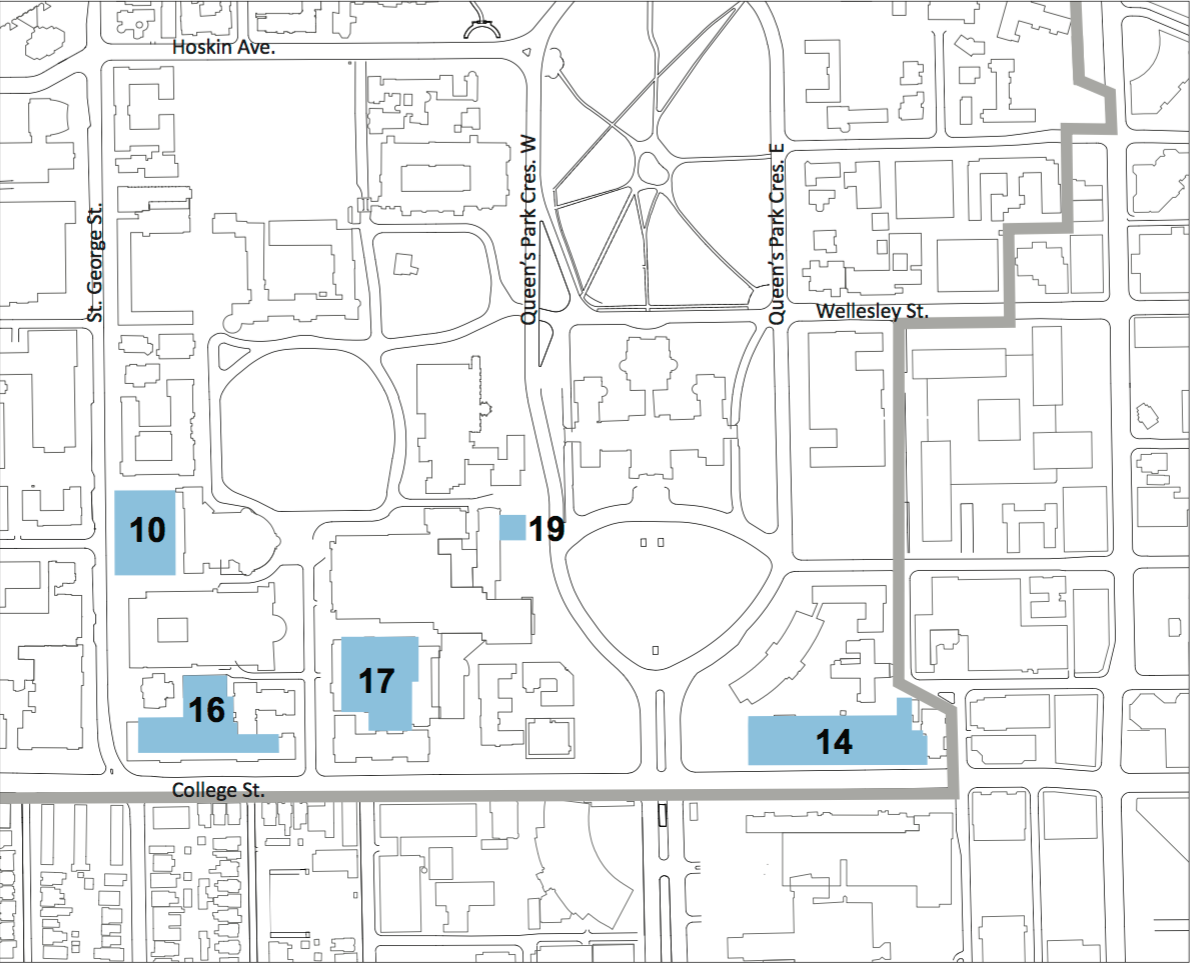 St. George Campus Master Site Plan development areas, image courtesy of the University of Toronto
St. George Campus Master Site Plan development areas, image courtesy of the University of Toronto
Heading west on College, just across the street from the St. George Campus is the future site of Parallax Investment Corporation's Theory Condos, on the southeast corner with Beverley. The developers appealed to the Ontario Municipal Board (OMB) based on the City's lack of a decision in the required timeframe. City Council voted to continue negotiating in advance of the OMB hearing, which was held in December last year. While a decision has not yet been made public, marketing for the project has started. We should know soon how close to the 29-storey ask was granted to the developers. Designed by Page & Steele / IBI Group Architects, the development proposes retail and commercial office space in the lower levels, while 309 residential units are proposed above.
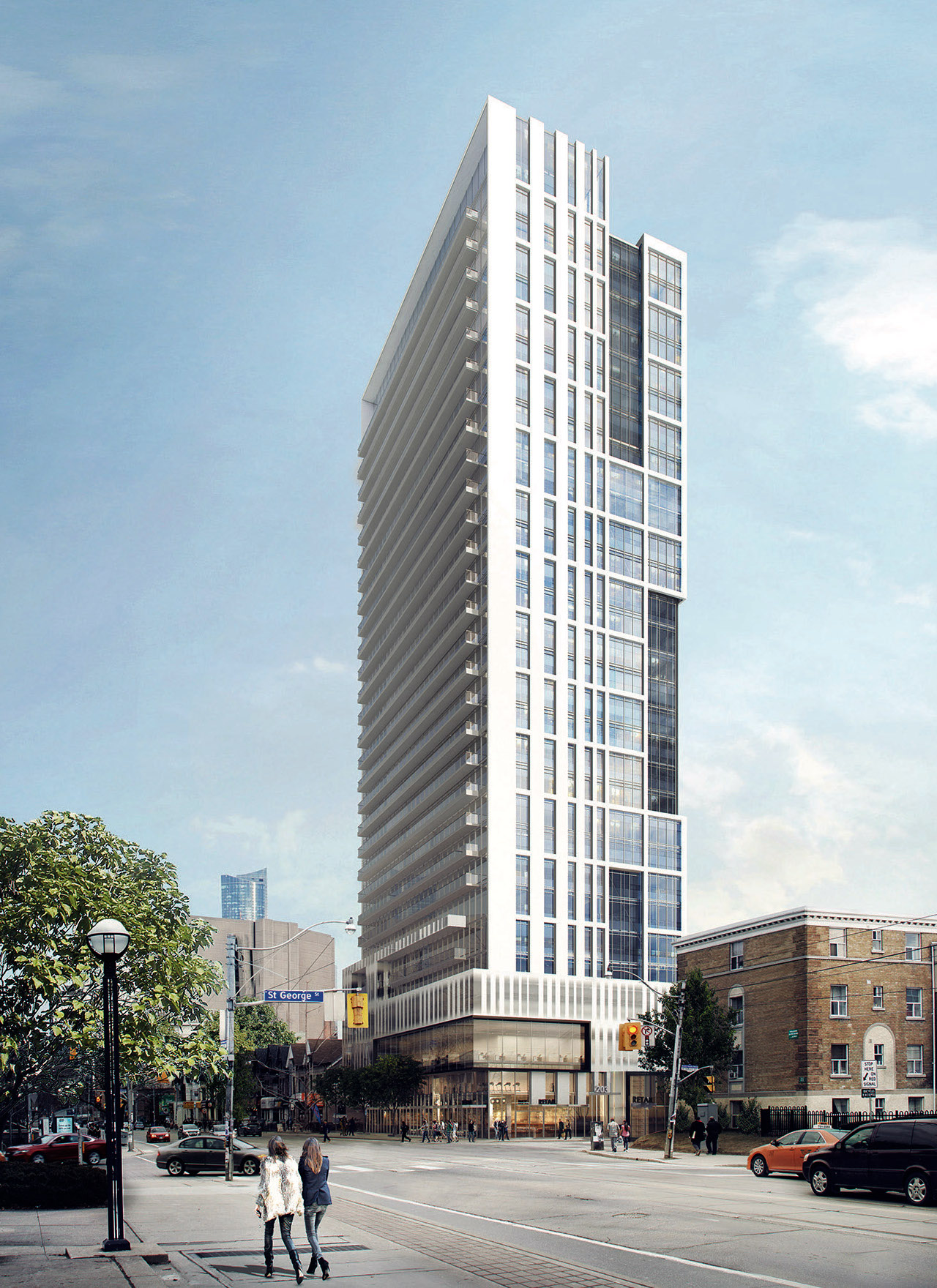 Rendering of 203 College Street, image courtesy of Parallax Investment Corporation
Rendering of 203 College Street, image courtesy of Parallax Investment Corporation
Heading northbound on St. George Street into the campus, the U of T's Centre for Engineering Innovation and Entrepreneurship is about halfway to its final height of eight storeys. Designed by the UK's Feilden Clegg Bradley Studios with Toronto's Montgomery Sisam, the designers are aiming to achieve LEED Gold certification through the use of sustainability features such as solar energy, heat recovery technologies, rainwater capture systems, and natural lighting. Completion is expected later this year.
 Rendering of the Centre For Engineering innovation and Entrepreneurship, image courtesy of the University of Toronto
Rendering of the Centre For Engineering innovation and Entrepreneurship, image courtesy of the University of Toronto
Further north at Harbord Street, the iconic Brutalist Robarts Library is set for a five-storey addition on its west side, while the renovation of other parts of the building continues. Attracting well over 18,000 visitors a day results in the building being over capacity, so the 50,000 square foot expansion will be a much needed addition to the 44-year old Mathers and Haldenby-designed facility. Architectural work is led by Diamond Schmitt Architects.
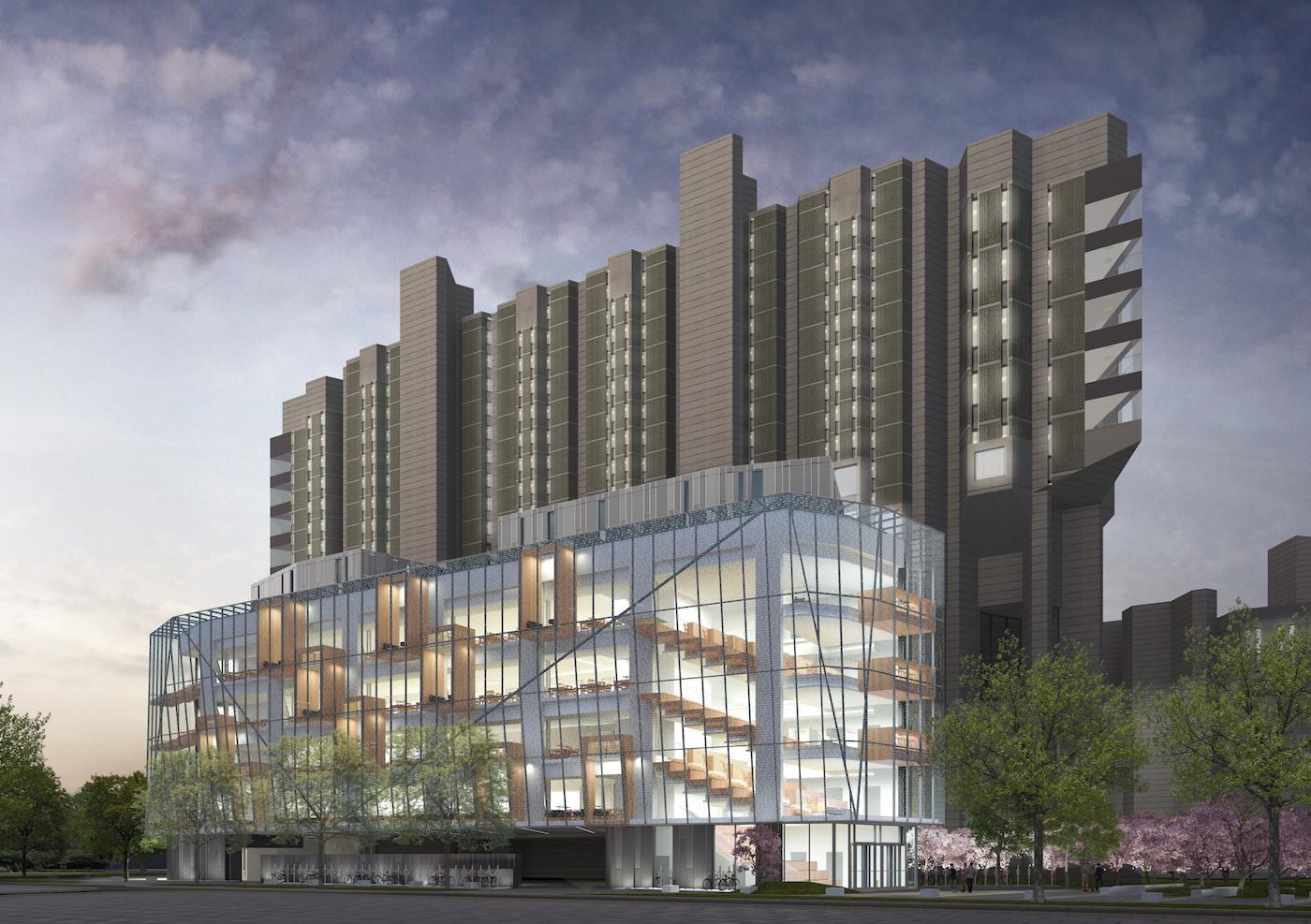 Rendering of the Robarts Library addition, image courtesy of Diamond Schmitt/Mathers & Haldenby
Rendering of the Robarts Library addition, image courtesy of Diamond Schmitt/Mathers & Haldenby
Continuing north, we turn west at Bloor Street. On the northwest corner at Madison Avenue is the site of 316 Bloor West, a proposed 42-storey mixed-use condominium by the State Building Group. Proposed with 535 residential units, retail would be provided at grade level. At the height of 450 feet, this Kirkor-designed building would be the over twice the height of anything in the immediate area. Appealed to the OMB, the City and the developers chose mediation, which took place earlier this month. A further hearing is scheduled for June this year, and we will know later this year at what size of building a settlement has been reached.
 Updated rendering of 316 Bloor West, image via submission to the City of Toronto
Updated rendering of 316 Bloor West, image via submission to the City of Toronto
Another block west at Spadina, construction is well underway one block to the north on the U of T's Jackman Institute of Child Study. Designed by Taylor Smyth Architects, the three-storey facility at 56-58 Spadina will add more classrooms, study space, and faculty offices to the growing experimental primary school.
 Jackman Institute of Child Studies under construction in January, image by Forum contributor Ottawan
Jackman Institute of Child Studies under construction in January, image by Forum contributor Ottawan
Turning around and heading south, a block past Bloor are a pair of 3-storey buildings at 698 Spadina, and where the Spadina and Sussex Mixed Use Residence is in its planning stages. Developed in partnership with U of T and The Daniels Corporation, the project calls for a 23-storey student residence building designed by Diamond Schmitt Architects, adding accommodations for just under 600 students once built out. Included would be retail at ground level, while commercial office will be leased out in the podium floors above. This proposal is part of the university's plan to add 2,300 new student residences by 2020.
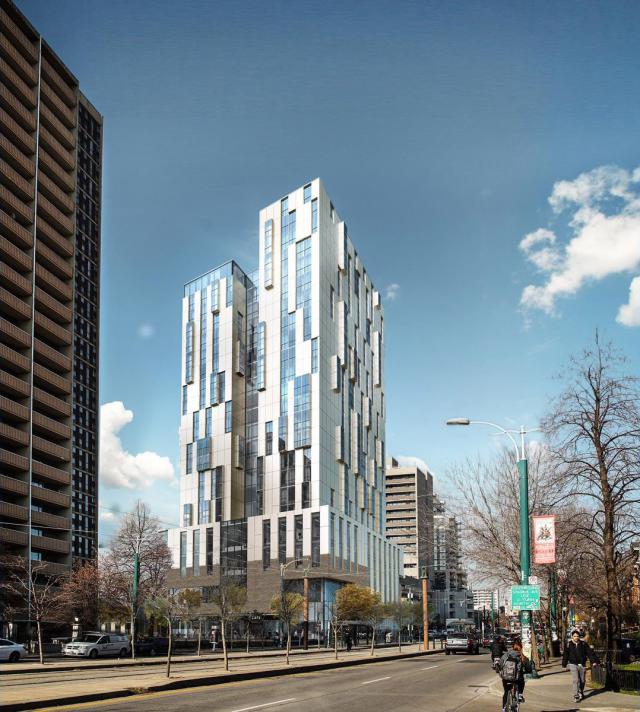 Rendering of Spadina and Sussex Mixed Use Residence, image courtesy of Diamond Schmitt Architects
Rendering of Spadina and Sussex Mixed Use Residence, image courtesy of Diamond Schmitt Architects
Across Sussex Avenue to the immediate south, a tower-in-the-park site at 666 Spadina has intensified use planned for it. Owners Cromwell Property Management have hired Page & Steele / IBI Group Architects to design infill developments beside the existing slab tower. The proposal includes a four-storey townhouse development fronting onto Sussex, while an 11-storey mid-rise would be built south of the tower. It would cascade on a 45-degree angular plane to transition to the height of the low-rise neighbourhood buildings to the west. Adding an additional 127 rental units to the site, the proposal has been the brunt of a fair share of NIMBYism from locals angry at the loss of the private green space where the new buildings would rise.
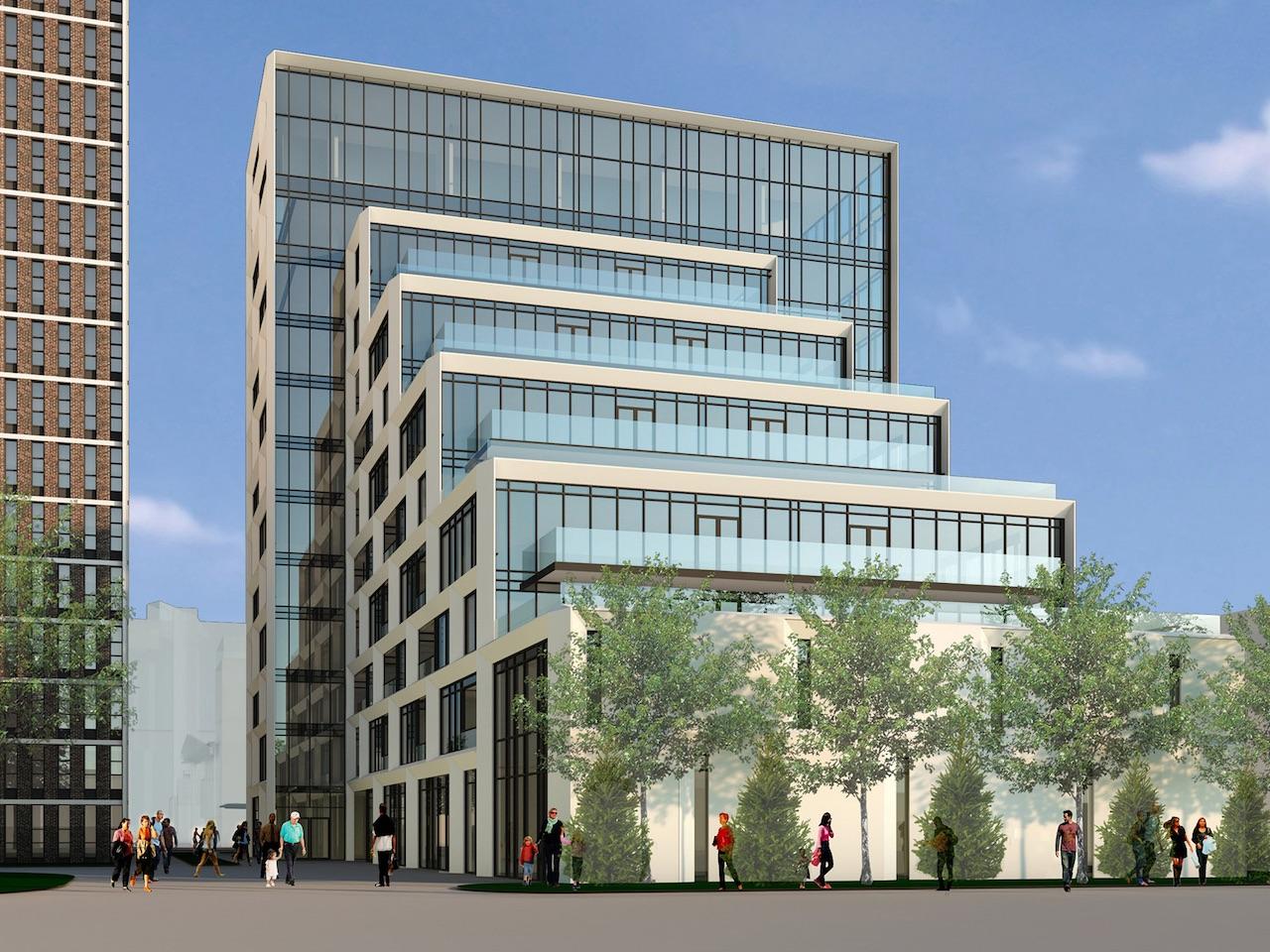 Rendering of 666 Spadina, image via submission to the City of Toronto
Rendering of 666 Spadina, image via submission to the City of Toronto
A long block further south, construction is wrapping up in advance of the Fall opening of the U of T's John H. Daniels Faculty of Architecture, Landscape, and Design at 1 Spadina Crescent. While a lot of work is still left on the north side three-storey contemporary addition, hoarding has been taken down around the extensively renovated and restorated 1875 building. With the design of the project by renowned Boston-based NADAAA, Toronto's Adamson Associates Architects, and heritage consultants ERA Architects, the new facility will breathe new life into a recently neglected and dilapidated site.
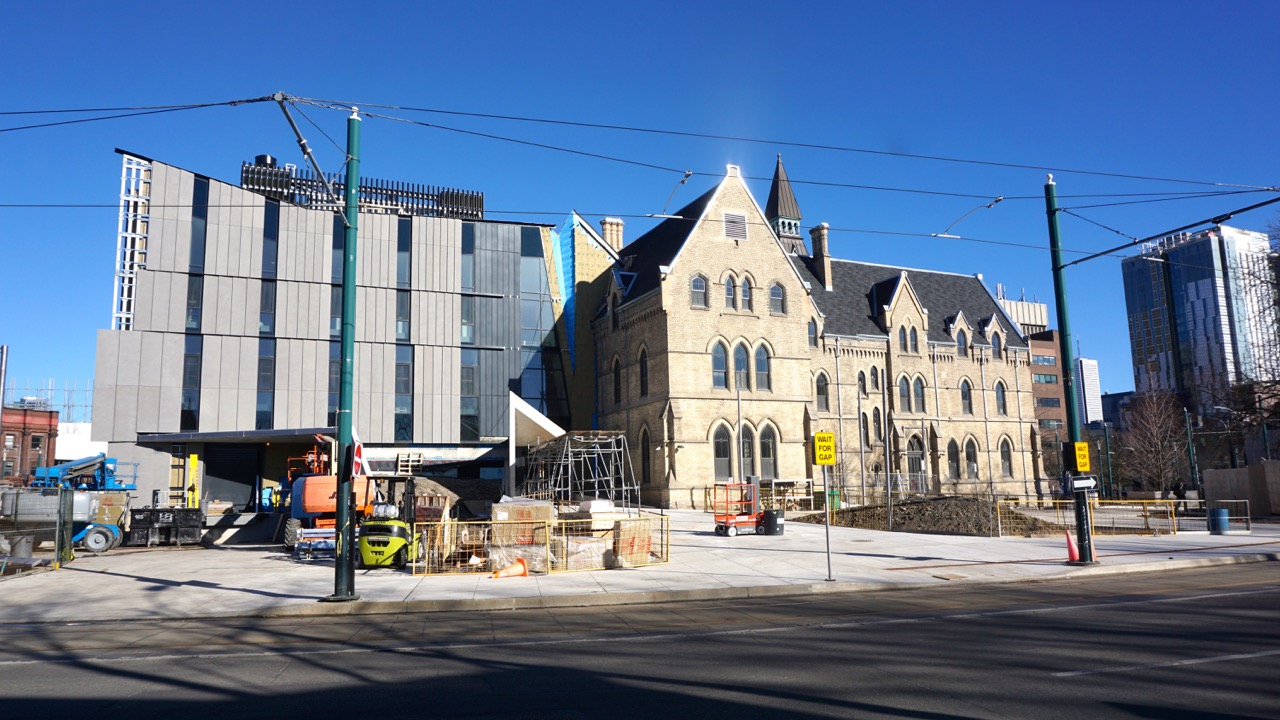 Daniels Faculty of Architecture, Landscape, and Design under construction in late February, image by Craig White
Daniels Faculty of Architecture, Landscape, and Design under construction in late February, image by Craig White
Doing a 180 around 1 Spadina Crescent, we arrive back at Willcocks Street, and turn east. The U of T has plans for this street that runs between Spadina and St. George, looking to pedestrianize it partly or fully for most of its length in the coming couple of years. You can find out more about the DTAH design for Willcocks Common, here.
 Willcocks Common in Summer, image by DTAH for the University of Toronto
Willcocks Common in Summer, image by DTAH for the University of Toronto
At Huron Street we turn south, and in two blocks arrive back at College Street, where from Huron westwards a string of developments are making their way either through the planning process or are already under construction.
Starting off with 231 College on the southeast corner, a proposal by Shiu Pong is currently seeking Site Plan Approval from the City, its zoning having been approved in September 2014 at 17 storeys. Dubbed Design Haus, the Kirkor Architects-designed project will have the facades of a three-storey heritage building incorporated into its base. There will be retail at grade level, with 142 residential units above, 26 of which will be rental replacement units.
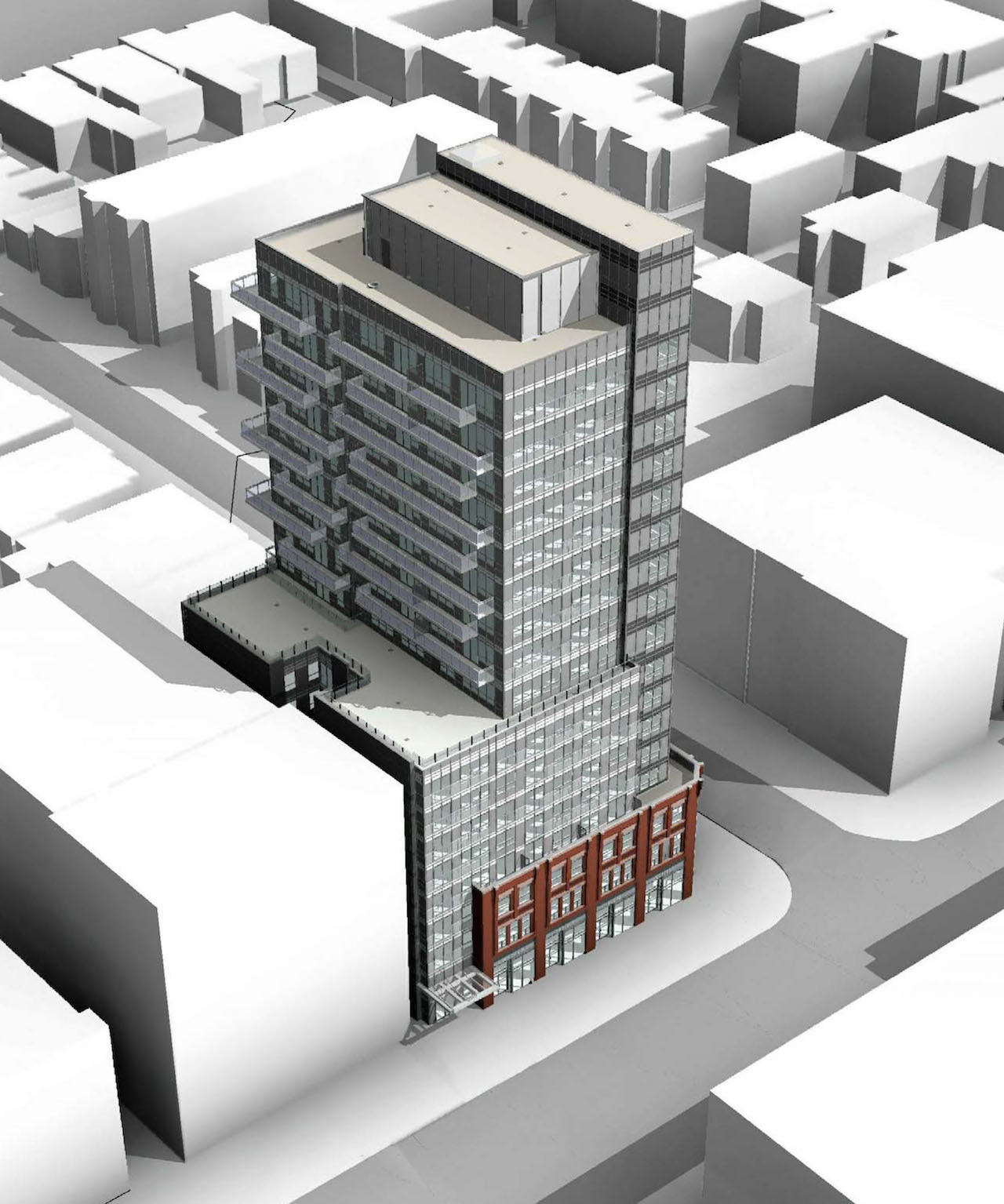 Updated rendering of Design Haus, image via submission to the City of Toronto
Updated rendering of Design Haus, image via submission to the City of Toronto
Across Huron Street to the west is the Lillian H. Smith Library, and immediately to the west of that, 243 College Street. In 2012, owners Baliey & Company submitted a rezoning application for a slender 30-storey mixed-use tower which would have replaced the ornate five-and-a-half-storey brick office building onsite. The project never made it through the planning process, but development pressure makes one wonder if this one might resurface.
Immediately next door at 245 College, Knightstone's CampusOne Student Residence topped-off in 2016, while its grey spandrel cladding is now being installed on the 25-storey building's stout flanks. Designed by Diamond Schmitt Architects, construction will carry on through the coming months in anticipation of a Fall 2017 opening. The building will house approximately 840 beds.
 Construction progressing at CampusOne Student Residence in March, image by Forum contributor Salsa
Construction progressing at CampusOne Student Residence in March, image by Forum contributor Salsa
Kitty corner across the intersection with Spadina, Toronto's legendary Silver Dollar Room will be restored as part of the 484 Spadina development by the Wynn Group. In a plan that originally called for a 22-storey mixed-use building designed by Kirkor, negotiations led to a revised plan of 15 storeys, and 303 rental units geared to students.
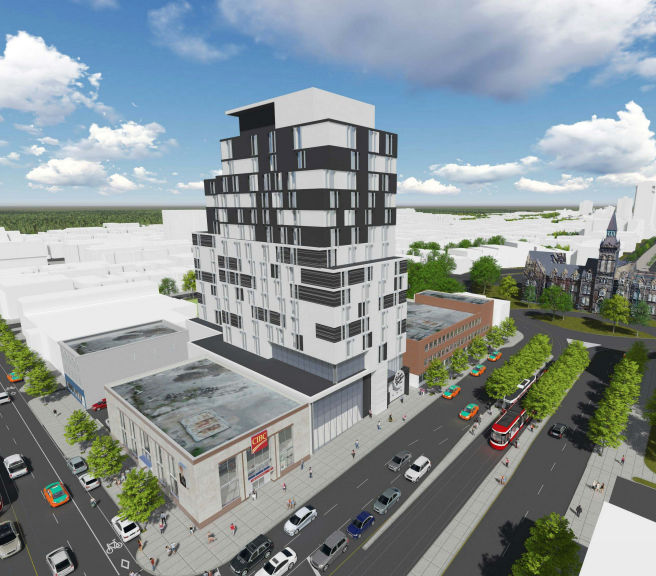 Rendering of 484 Spadina, image courtesy of the Wynn Group
Rendering of 484 Spadina, image courtesy of the Wynn Group
In the next block to the west on College on the south side, plans are in the works by BRL Realty to redevelop the auto rental site at 333 College with a 13-storey mixed-use building. Designed by RAW, the proposal would bring 164 residential units to the site.
 Rendering of 333 College Street, image via submission to the City of Toronto
Rendering of 333 College Street, image via submission to the City of Toronto
Arriving at Bathurst, we take a detour south for one block to where workers recently installed the crane to build the Bathurst College Centre. Excavation is wrapping up on the RioCan project, and construction will begin soon on the Turner Fleischer Architects-designed commercial complex. Its 150,000 square feet on four storeys will be divided into 70,000 square feet of offices and 80,000 square feet of retail. Completion is expected in sometime in 2018.
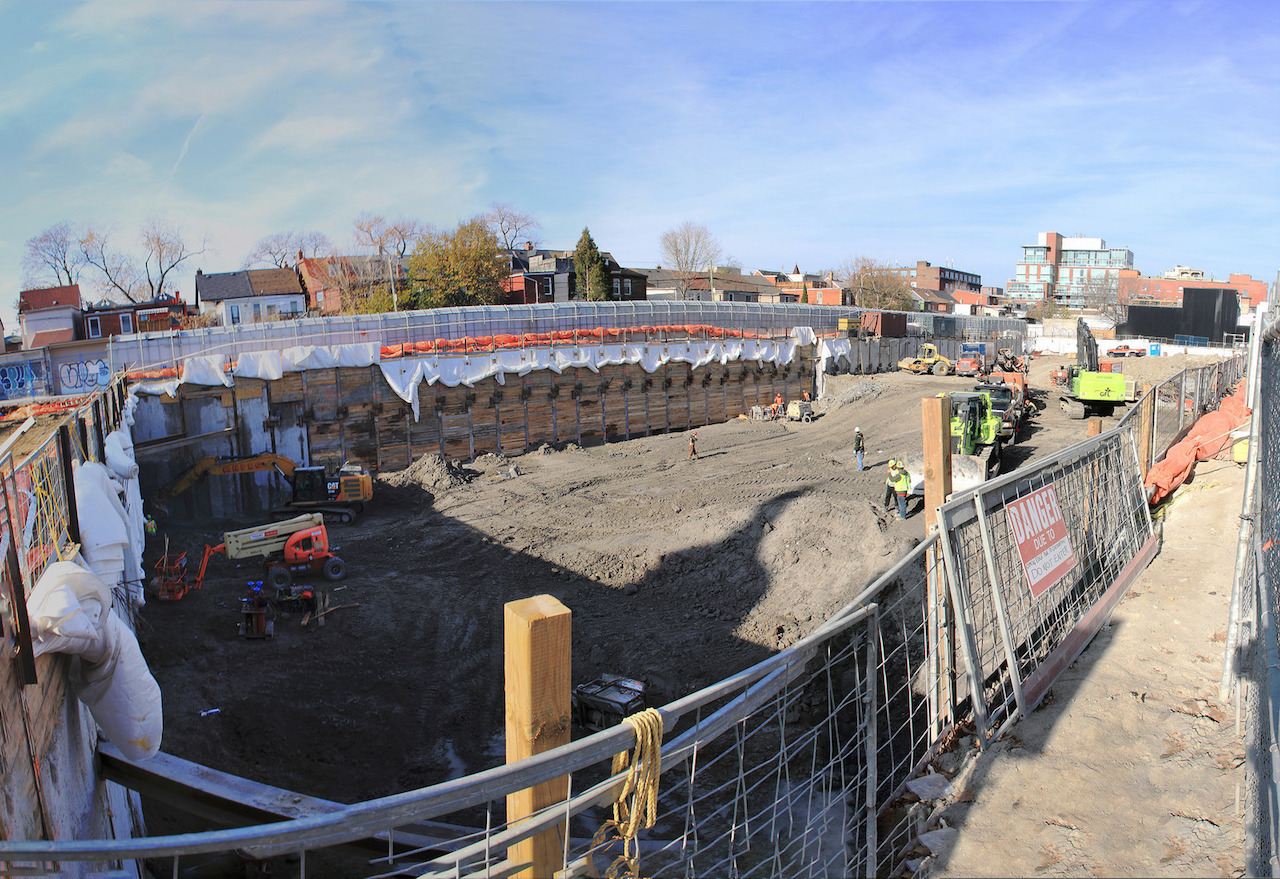 Excavation progressing at Bathurst College Centre in late 2016, image by Forum contributor Drum118
Excavation progressing at Bathurst College Centre in late 2016, image by Forum contributor Drum118
Back on College westbound again, the 1910-built Classical Revival facade of the former Latvian House and its adjoining surface parking lot at 491 College is currently under construction. It's to be another new commercial property for RioCan, in partnership here with Allied Properties REIT. Also designed by Turner Fleischer Architects, the building is set to open in Spring 2018, with an LCBO occupying 8,000 square feet on the ground floor. The heritage facade will become the entry to offices on the second and third floors.
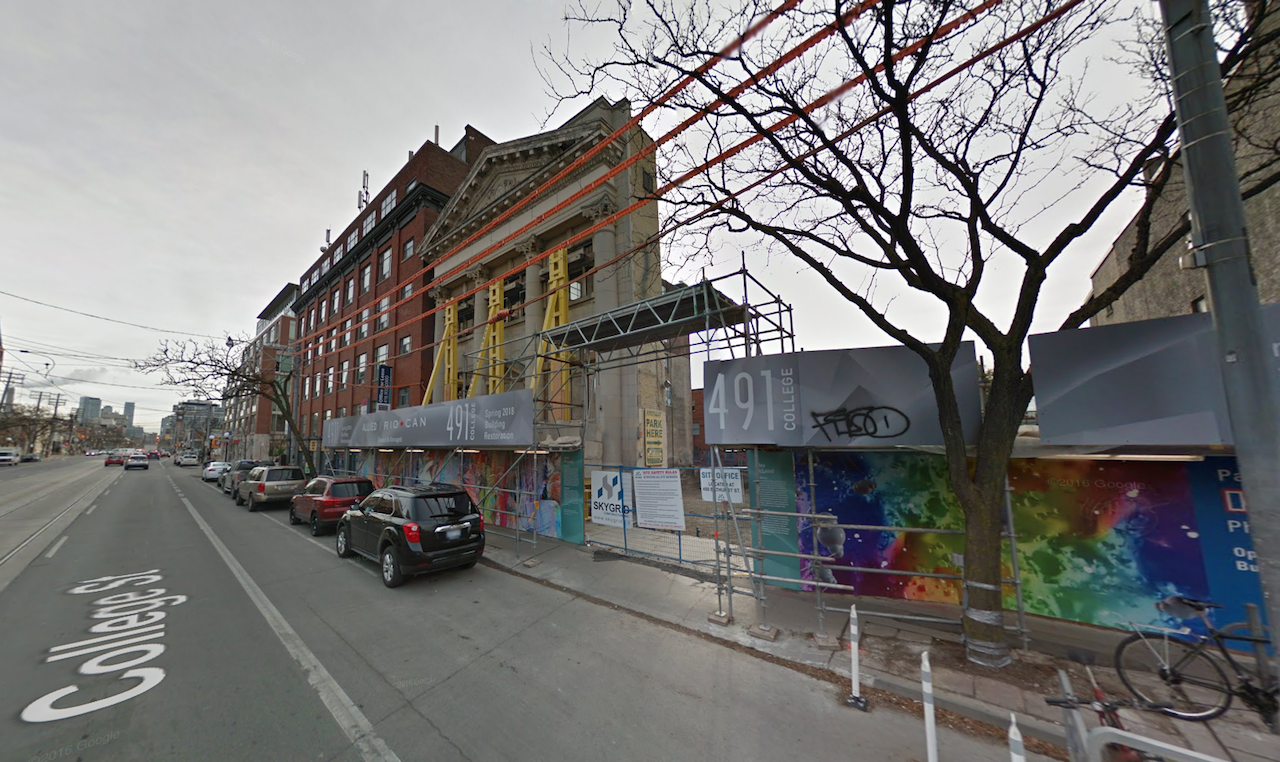 Latvian House under construction in late 2016, image courtesy of Google Maps
Latvian House under construction in late 2016, image courtesy of Google Maps
Two blocks west, midway between Euclid and Manning Avenues, a third Turner Fleischer designed building will soon rise in the area where RioCan and Allied have another 50/50 joint venture at 547 through 557 College. Currently a parking lot and a pair of low-rise commercial buildings, one of the commercial properties is the current local LCBO. Once it has relocated to the 491 College site above, the developers will be able to rebuild on this site, where they plan the 555 College Apartments. The 8-storey building will have two retail suites at ground level.
 Rendering of 555 College Apartments, image via submission to the City of Toronto
Rendering of 555 College Apartments, image via submission to the City of Toronto
A pre-application consultation was recently held for a proposal nine blocks further west, at the site at 871-899 College Street, for a seven-storey mixed-use building by the Clifton Blake Group. The development plans include retail at ground level with 120 residential units on the upper six floors, 13 of them rental replacement units. An application is expected to be submitted to City Planning relatively soon.
At Dovercourt Road, we turn south, then turn again at Dundas Street, going all the way east to the site of the Alexandra Park revitalization past Bathurst Street. A major redevelopment by the Toronto Community Housing Corporation (TCHC) and Tridel of the land south of Dundas between Denison and Cameron streets, the 18-acre site includes new and replaced rent-geared-to income units, about 1,500 market units, new townhouses, public space, reconnected streets, institutional space, Co-ops, and retail space. Once the entire revitalization is complete—likely in over a decade's time—the project will have over 2,300 residential units.
 Early massing model of the Alexandra Park revitalization, image courtesy of TCHC
Early massing model of the Alexandra Park revitalization, image courtesy of TCHC
Amongst the first projects to be nearing completion here is SQ Spadina Queen Condos on Cameron Street. Designed by Teeple Architects, the 14-storey condo is nearing completion, with balcony cladding remaining to install on the exterior, while interior work is in full swing. Residential occupancy should begin within a few months.
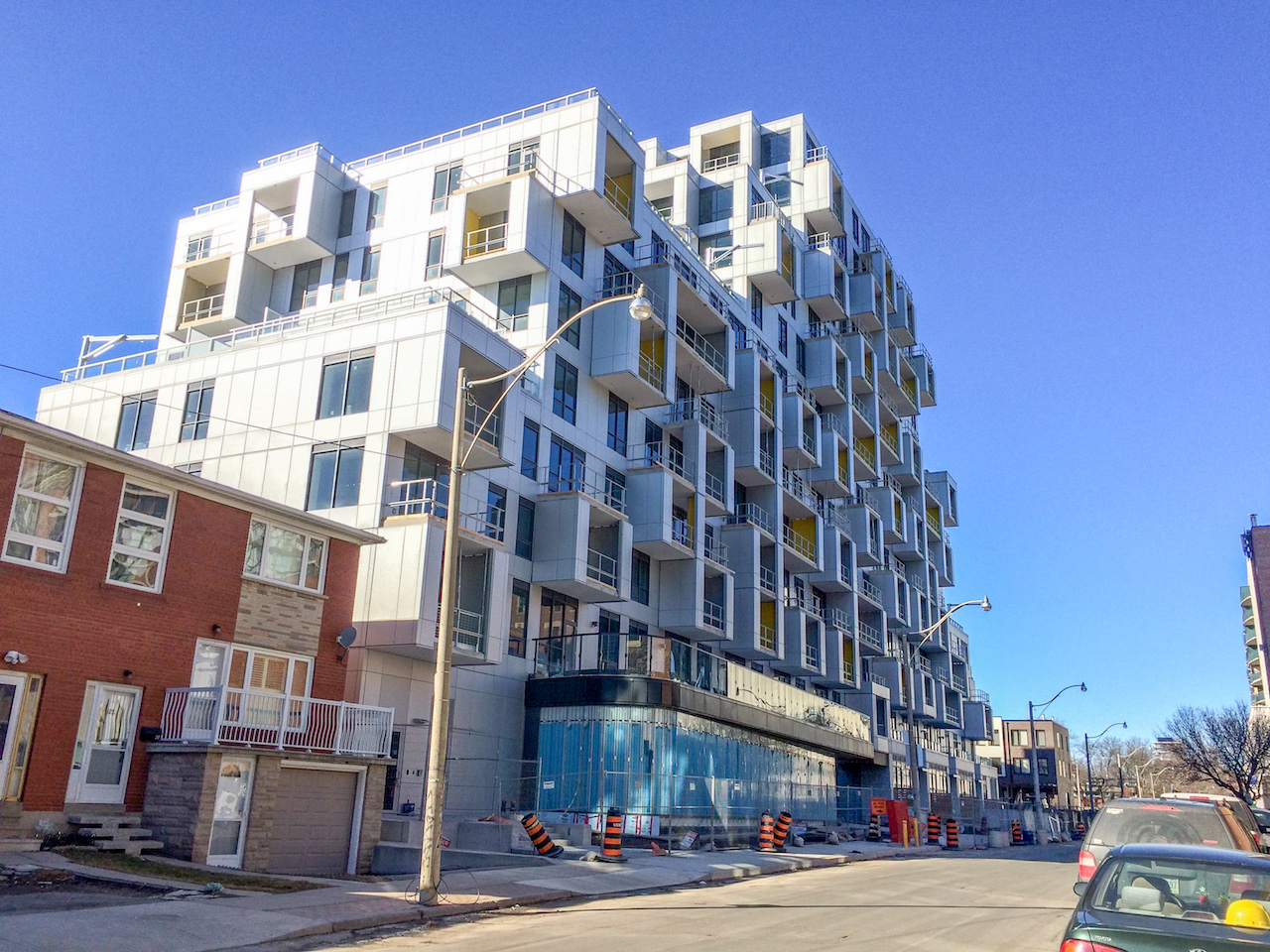 SQ Spadina Queen Condos under construction in February, image by Forum contributor agoraflaneur
SQ Spadina Queen Condos under construction in February, image by Forum contributor agoraflaneur
Shoring work began for the second phase, SQ2, in February, with excavation set to kick off very soon. To be built on Augusta Avenue to the west of its predecessor and also designed by Teeple for Tridel, SQ2 will also be 14 storeys tall, with 169 residential units anticipated. New townhomes for TCHC have already opened on Vanauley Street and the newly built Paul Lane Gardens in association with SQ, and more will come along with the SQ2 work.
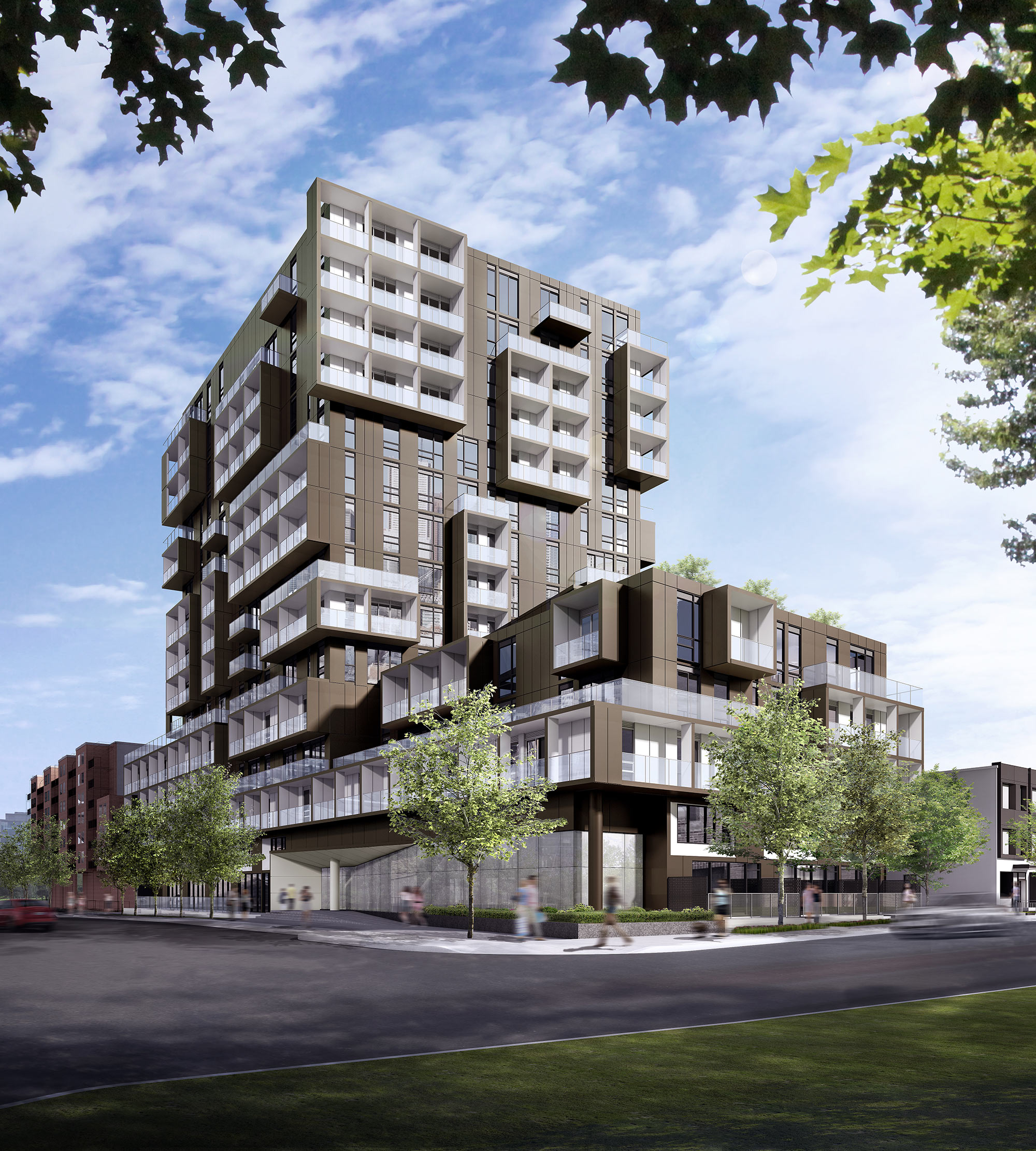 Rendering of SQ2 Condos at Alexandra Park, image courtesy of Tridel
Rendering of SQ2 Condos at Alexandra Park, image courtesy of Tridel
Just to the east of Alexandra Park is Spadina Avenue, and in the block north of Queen Street, a proposal to redevelop 170 Spadina—the third proposal for the site in the last half dozen years—was turned down by the OMB recently. Originally proposed by Tri-Win International at 19-storeys, and then appealed to the OMB at 17 after the City failed to make a decision in the required time, the site was sold to Plazacorp in 2015. Plaza continued negotiations with the City in advance of the OMB hearing, but the two sides did not resolve their differences before the hearing. The OMB ruled—in agreement with the City—that the proposal is out of line with the character of the neighbourhood, and that it would not accept anything over 12 storeys, which is equal to the width of Spadina. As there were no renderings released of the Plaza design by Quadrangle Architects, we include an image of the last Tri-Win design by Wallman Architects, at 15 storeys, which would have included 162 residential units. We will see if a new proposal emerges for the site this year.
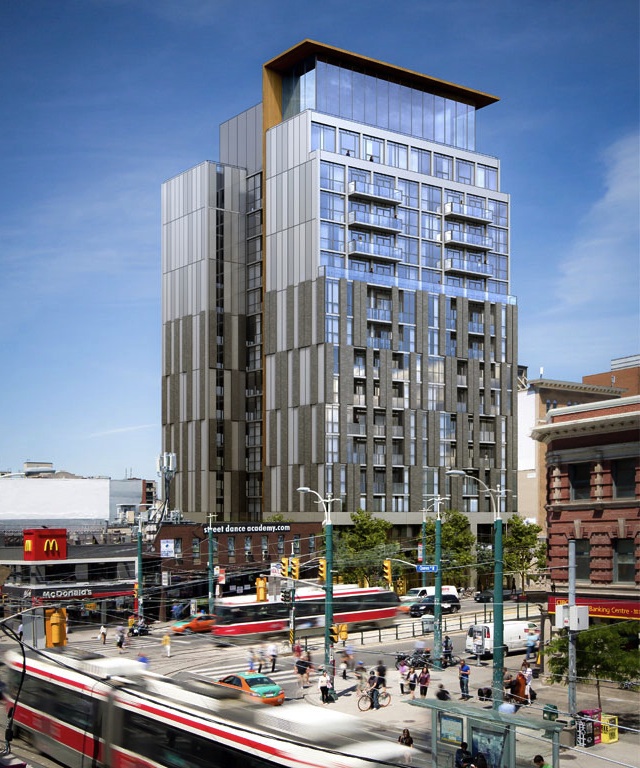 Earlier rendering of 170 Spadina, image courtesy of Wallman Architects
Earlier rendering of 170 Spadina, image courtesy of Wallman Architects
Now moving eastbound on Toronto's beloved Queen West street, a proposal by The Pearl Group was recently approved to build a four-storey commercial retail and office building on the section of wide sidewalks on north side east of Spadina. Designed by Turner Fleischer Architects, the project, in scale with its neighbours, will replace the existing single-storey retail building at 336 Queen West.
 Rendering of 336 Queen Street West, image courtesy of The Pearl Group
Rendering of 336 Queen Street West, image courtesy of The Pearl Group
Just a stone's throw east of this, a Mountain Equipment Coop store will soon replace the large surface parking lot at the east end of this same block. The three-storey mixed-use building designed by Sweeny &Co Architects will be the new location of the MEC store now a couple of blocks to the south on King Street. Along with the two level store, a daycare will be located on the third floor, taking advantage of a roof deck. Fencing went up a couple months ago, and the start of shoring began shortly after.
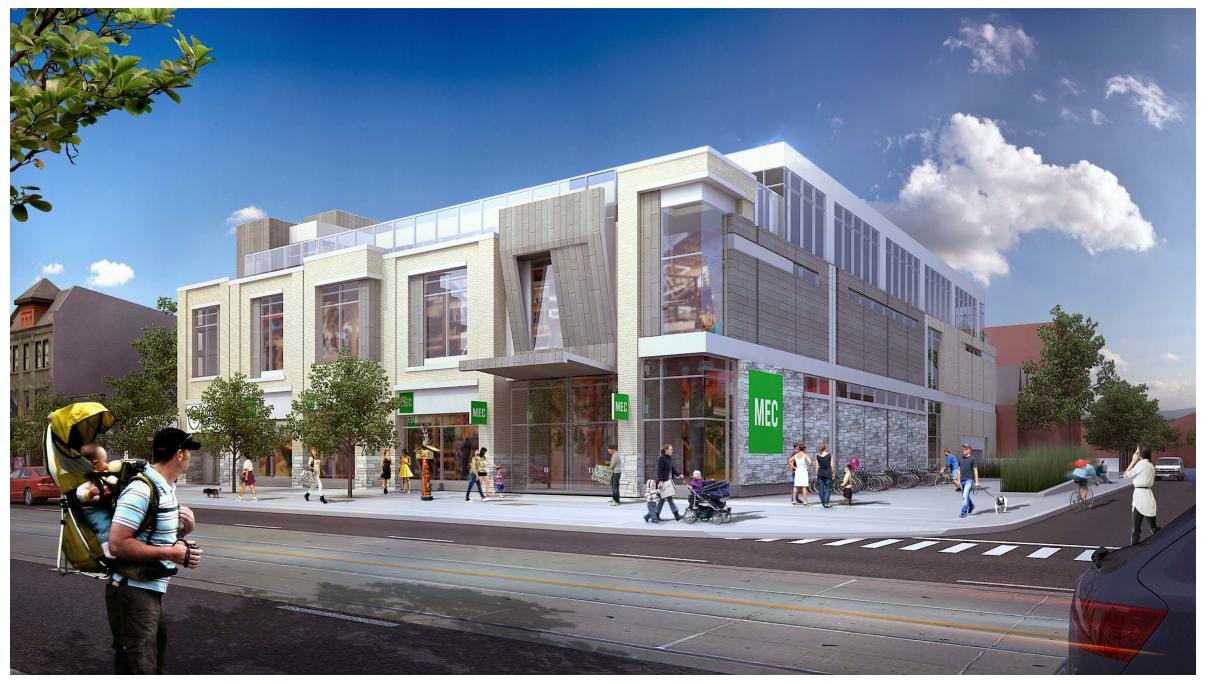 Rendering of the Mountain Equipment Coop Store, image via submission to the City of Toronto
Rendering of the Mountain Equipment Coop Store, image via submission to the City of Toronto
Two blocks east and just a few steps north on John St, construction is ongoing at the site of Allied REIT's 180 John St. A 1914 built five-storey red brick heritage building, ERA Architects and Gensler have teamed up to create a three-storey addition to the top of the existing building. Similar to 336 Queen West above, the top of this addition will feature an outdoor terrace for office tenants.
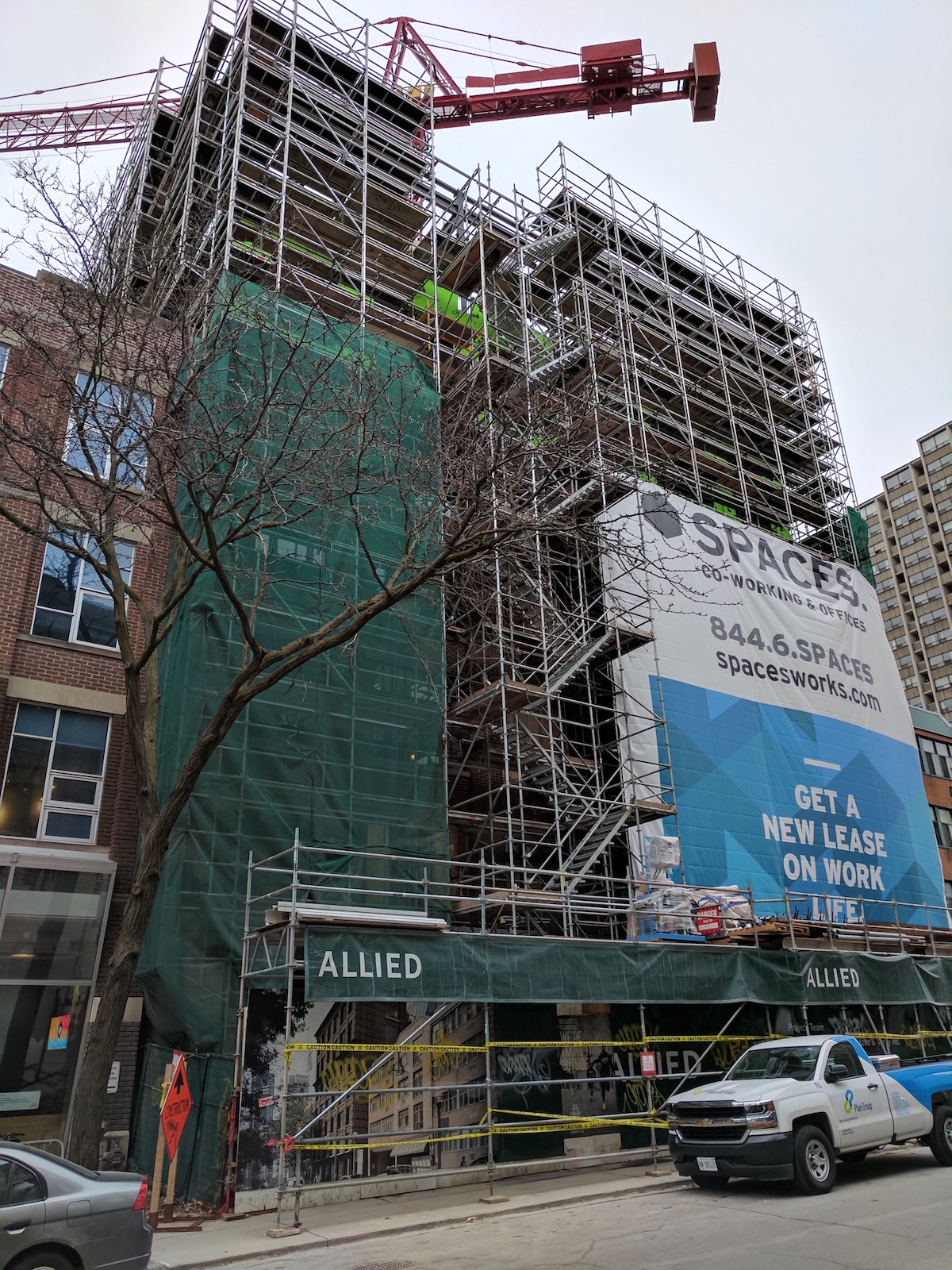 Construction at 180 John St in February, image by Forum contributor AHK
Construction at 180 John St in February, image by Forum contributor AHK
Continuing north on John St, we arrive at the foot of Grange Park. At the end of 2016, construction work to revitalize the park was 80% complete, with work recommencing in April following a temporary halt at the end of February. Led by Thinc Design and Phillips Farevaag Smallenberg, items left to finish include children's play areas, water features, public furniture, the off-leash dog area, and the addition of 60 new trees. Other work includes upgrades to washroom facilities and a new maintenance building, while the controversial relocation of Henry Moore's beloved Two Large Forms from Dundas and McCaul should take place anytime now. Work is targeted to be finished by the summer.
 Rendering of the Grange Park Revitalization, image courtesy of Phillips Farevaag Smallenberg
Rendering of the Grange Park Revitalization, image courtesy of Phillips Farevaag Smallenberg
The renewed park will include a more direct access to McCaul Street under OCAD's elevated Sharp Centre of Design. South on McCaul, fencing now surrounds 36 McCaul, where Tridel is now preparing to build Form Condos. Designed by architectsAlliance, the 14-storey condo brings neo-modernist flare to its shifted drawers design, with varying vertical fins playing with light on two floor-blocks of the building. With site clearance just beginning, we should have lots to follow for the construction of this building over this year and next.
 Updated rendering of Form Condos, image courtesy of architectsAlliance
Updated rendering of Form Condos, image courtesy of architectsAlliance
Right across the street at 35 McCaul, a three-storey addition has been approved for a four-storey brick office building. Designed by Giancarlo Garofolo Architect Inc for The Commercial Realty Group, the project will bring increased office space to the site, as well as new retail at grade level.
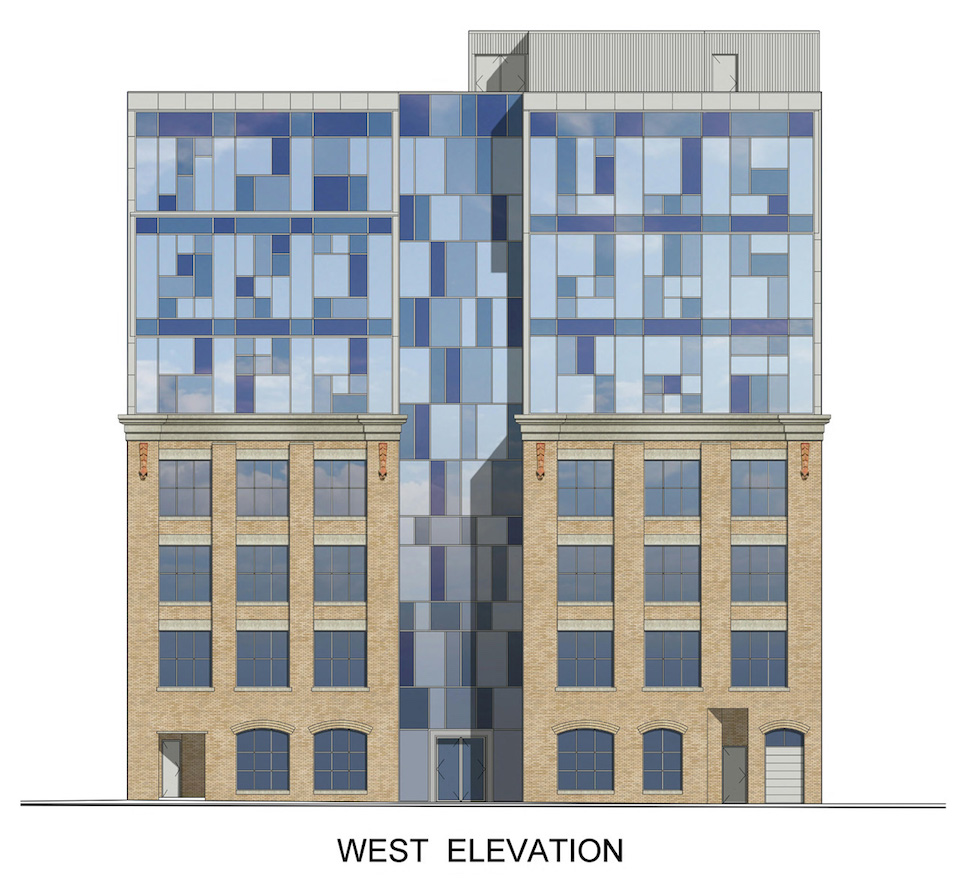 Looking east to 35 McCaul by Giancarlo Garofalo Architect for The Commercial Realty Group
Looking east to 35 McCaul by Giancarlo Garofalo Architect for The Commercial Realty Group
Returning to Queen, we turn east again and see across the street,a few steps south of the Rex Hotel, that Smart House by Urban Capital Property Group and Malibu Investments is now on its fifth level of construction. Designed by architectsAlliance with interiors by ll By lV DESIGN, this micro unit condo with special built-ins will rise 25 storeys, and is anticipating a 2018 completion and occupancy. The smallest units in this building will start at 289 square feet, with the largest units at 778 square feet.
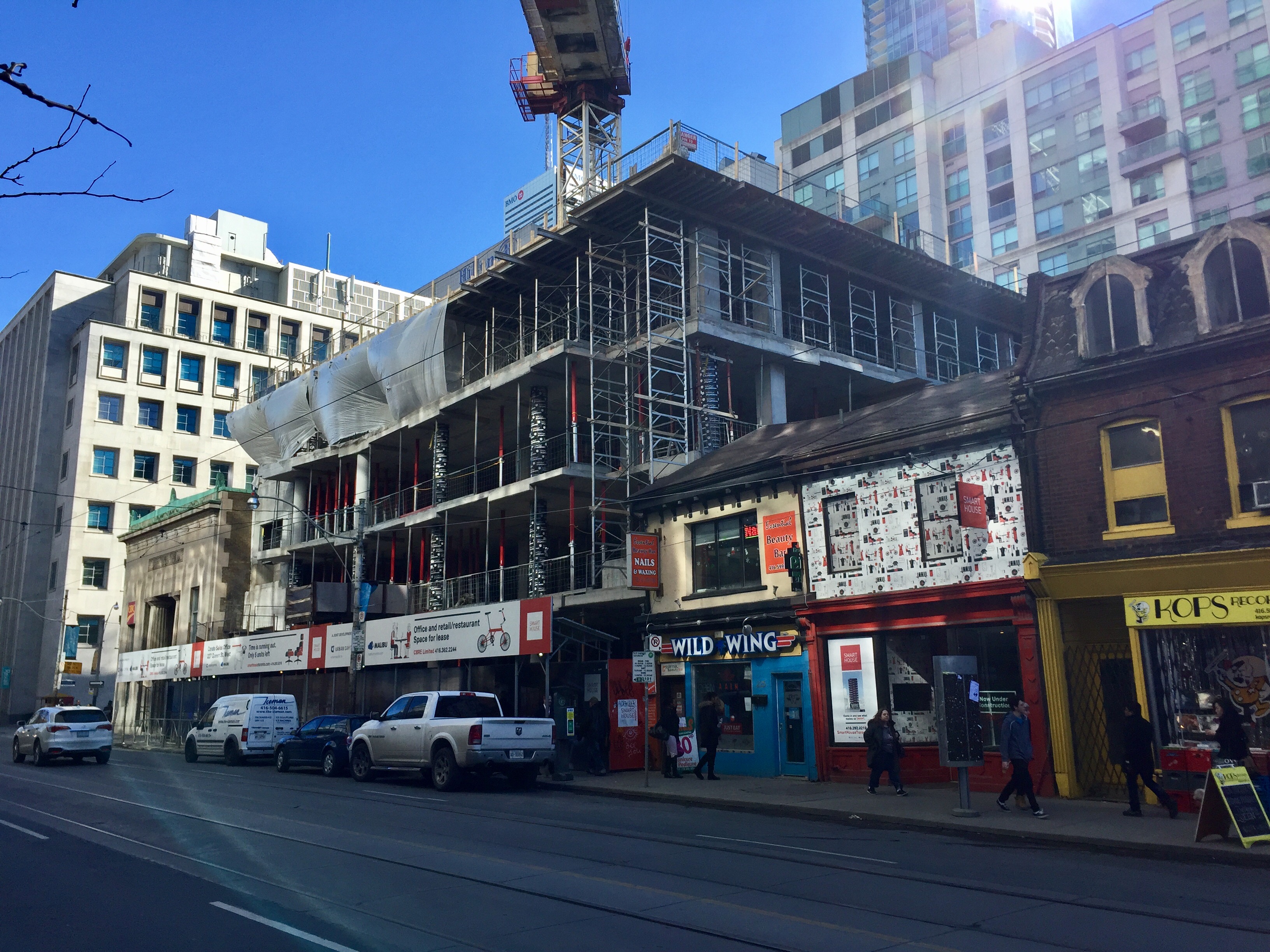 Smart House under construction mid-February, image by UT Forum contributor mcornett
Smart House under construction mid-February, image by UT Forum contributor mcornett
Turning north on St. Patrick Street, we soon arrive at the site where Artists' Alley by Lanterra Developments' is set to be built. Designed by Hariri Pontarini Architects, this ambitious project which includes properties at 121 St. Patrick and 234 Simcoe, is working its way through the planning process. Presented at the Design Review Panel (DRP) in February, the latest version is less dense than the first, with the taller towers on Simcoe now 39 storeys and just shy of 400 residential units, and 36 storeys with 310 units.The shorter high-rise on St. Patrick is still planned at 17 storeys and 210 units. The new version includes more public space at ground level, with better pedestrian circulation. Retail is proposed to front the public space, while offices are proposed on levels 2 through 4 of the south tower on Simcoe.
 Updated rendering of Artists' Alley, image courtesy of Hariri Pontarini Architects
Updated rendering of Artists' Alley, image courtesy of Hariri Pontarini Architects
Across from Artists' Alley, we walk through an entrance to Village by the Grange, and emerge on McCaul Street again opposite OCAD University, with two projects here currently in planning. First, OCAD is proposing a major addition and renovation to their main building at 100 McCaul St. The renovation encompasses about 95,000 square feet, while an addition would bring about 55,000 square feet of new space to the building. With architectural work led by renowned Los Angeles-based Thom Mayne of Morphosis, the new facility could become a new landmark to Toronto. With no final plans to reveal yet, a rendering from a massing study by Diamond Schmitt Architects appears below.
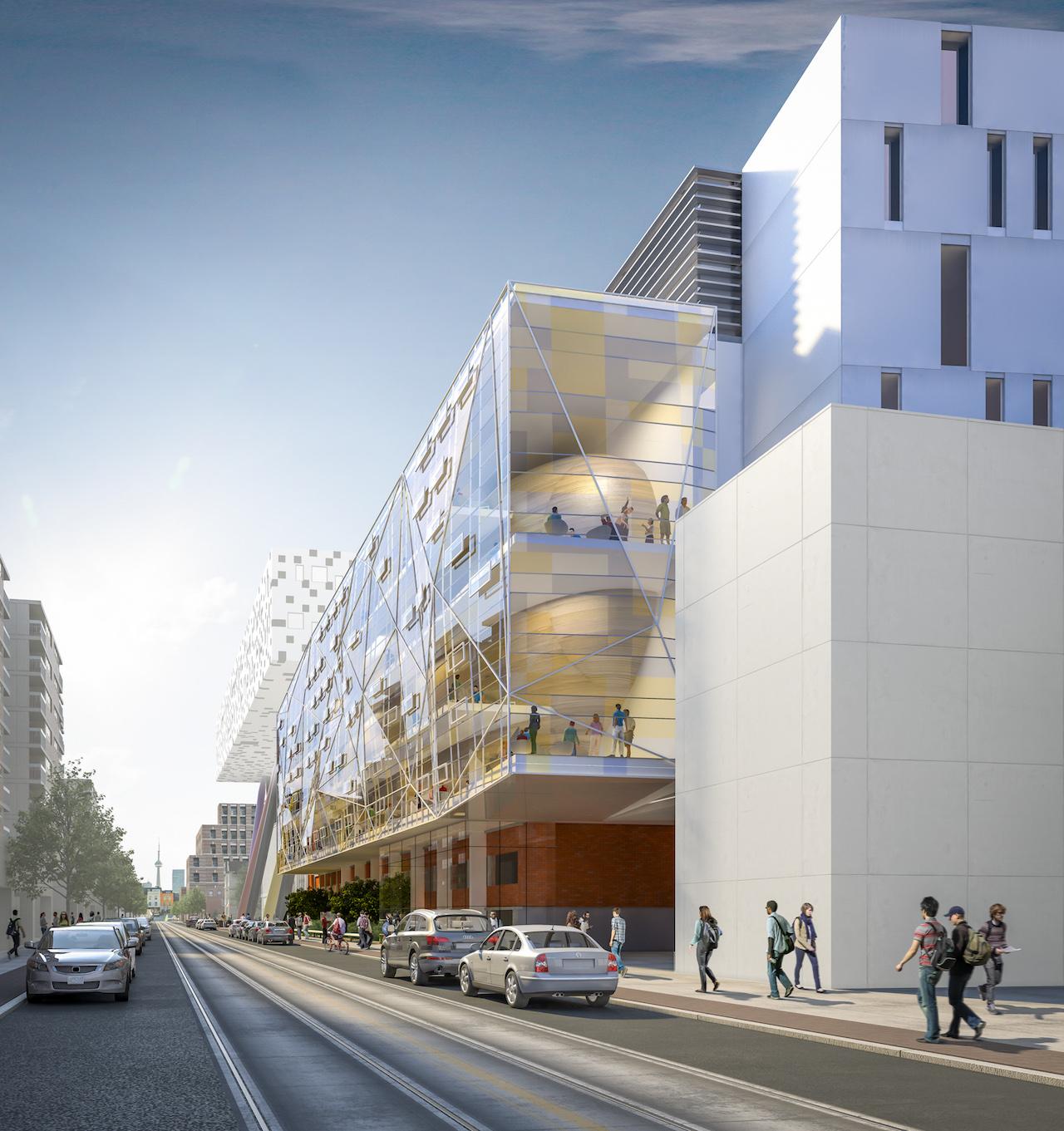 Outdated concept of 100 McCaul Street by Diamond Schmitt Architects
Outdated concept of 100 McCaul Street by Diamond Schmitt Architects
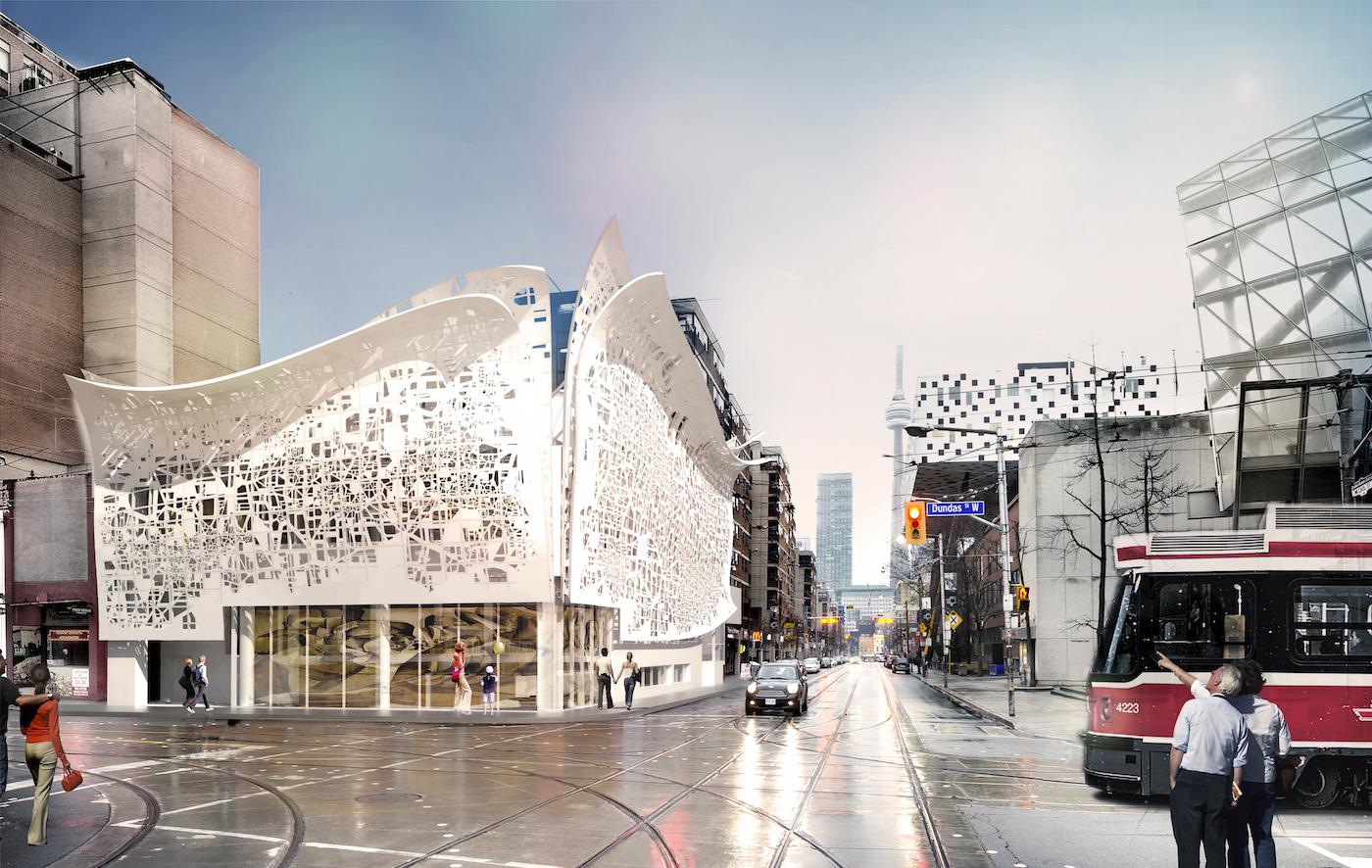 Rendering of the Rosalie Sharp Pavilion, image courtesy of Bortolotto Design Architect
Rendering of the Rosalie Sharp Pavilion, image courtesy of Bortolotto Design Architect
* * *
That completes the tour of the U of T area and west of Downtown of our Growth To Watch For 2017 series, leaving us with only two more segments to cover this year. Additional information and renderings can be found in each project's dataBase file, linked below. Want to share your thoughts on any of these developments? Feel free to comment, using the space provided below, or join in the conversation in the Forum thread associated with each project.

 3.7K
3.7K 



